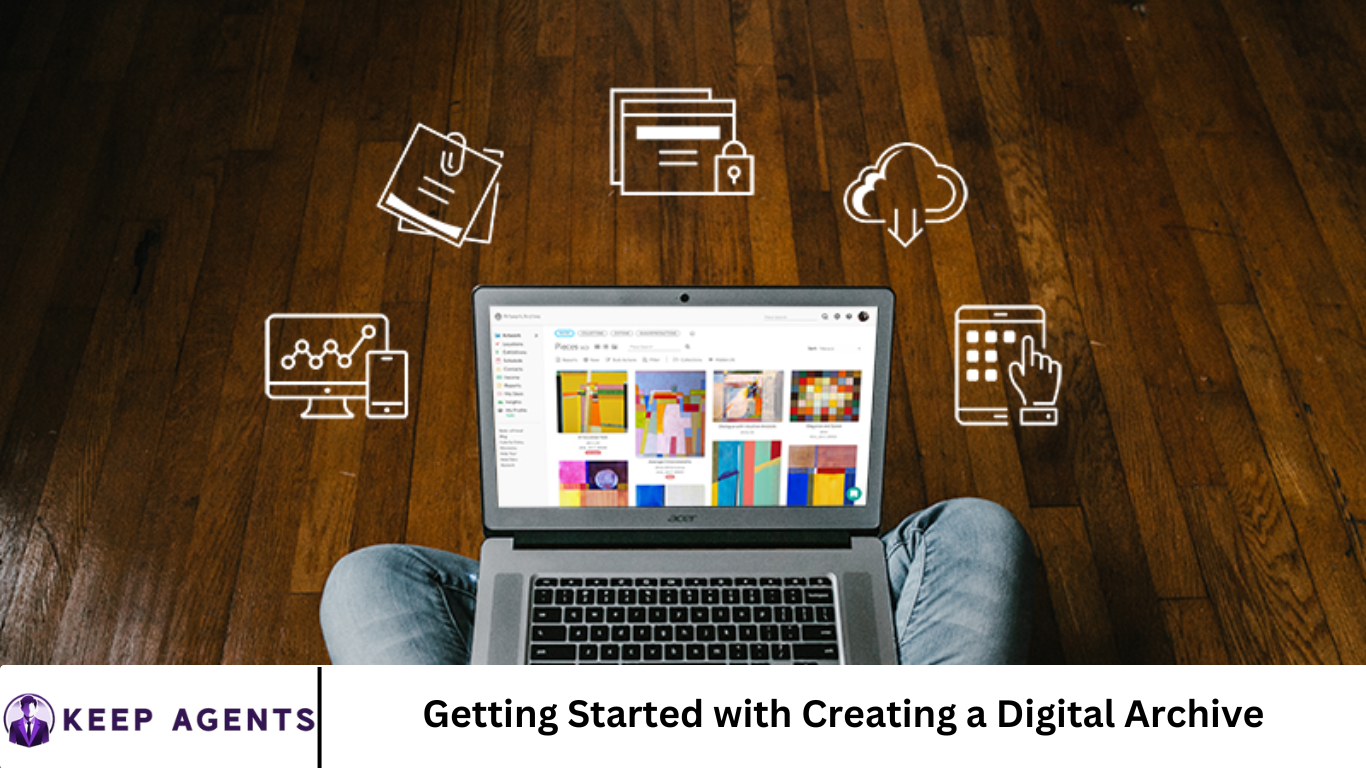Creating a digital archive is a powerful way to preserve, organize, and share information for long-term access. Whether you’re a historian, librarian, researcher, artist, or organization, building a digital archive ensures that valuable materials are safeguarded against physical degradation and accessible to a global audience.
In this comprehensive guide, we’ll explore everything you need to know about getting started with creating a digital archive, including planning, tools, metadata standards, best practices, and ongoing maintenance.
More Read: 7 Creative Ways to Record Your Parent or Grandparent’s Life Stories
What Is a Digital Archive?
A digital archive is a structured collection of digital materials, such as documents, images, audio, video, and metadata, that are preserved for long-term access and use. Unlike traditional archives that rely on physical storage, digital archives utilize digital technologies to ensure materials are stored securely, can be easily retrieved, and are protected from physical damage.
Why Create a Digital Archive?
There are several reasons to create a digital archive:
- Preservation: Protect fragile or at-risk materials from physical deterioration.
- Accessibility: Make resources easily available to a broader audience.
- Organization: Systematically categorize and store materials for efficient retrieval.
- Collaboration: Share archival materials across institutions or communities.
- Compliance: Meet legal or institutional requirements for data retention.
Step 1: Define Your Purpose and Scope
Before diving into technical tools, it’s essential to clearly define the purpose of your digital archive:
- Audience: Who will use this archive? (Researchers, students, the public?)
- Content: What types of materials will be archived? (Photos, letters, oral histories?)
- Scale: How much material will be digitized? Is this an ongoing project or a finite collection?
Having a well-defined scope helps determine the technologies and resources you’ll need.
Step 2: Plan Your Archive Structure
Next, outline how your digital archive will be organized:
- Hierarchical Structure: Consider using a hierarchical structure, such as collections > series > items.
- Naming Conventions: Develop standardized file naming conventions for consistency.
- Metadata Framework: Choose a metadata schema (Dublin Core, MODS, METS, EAD, etc.) to describe your materials effectively.
Step 3: Digitize Physical Materials
If you’re starting with physical items, you’ll need to digitize them:
- Scanning: Use high-resolution scanners for documents and photos (minimum 300 dpi, ideally 600 dpi for preservation-quality).
- Photography: For 3D objects, use digital photography with proper lighting and backgrounds.
- Audio/Video Conversion: Use professional digitization tools to convert tapes or reels into digital formats (WAV for audio, MP4 for video).
Step 4: Choose the Right Tools and Software
Selecting appropriate tools is crucial for managing and storing digital content. Common categories include:
Digital Asset Management (DAM) Systems
- CONTENTdm
- Islandora
- Omeka
- ArchivesSpace
File Storage and Backup
- Cloud Storage: Google Drive, Dropbox, Amazon S3.
- Local Storage: RAID servers, external hard drives.
- Backup Strategy: Implement the 3-2-1 rule (3 copies, 2 media types, 1 offsite copy).
Metadata Management Tools
- OpenRefine
- Oxygen XML Editor
Step 5: Apply Metadata and Descriptive Standards
Metadata is the backbone of a functional digital archive. It ensures materials are searchable and understandable over time.
- Descriptive Metadata: Title, creator, date, description, subject, keywords.
- Administrative Metadata: File type, digitization method, rights management.
- Technical Metadata: Format, compression, hardware/software used.
- Standards to Consider:
- Dublin Core: General-purpose and widely used.
- EAD (Encoded Archival Description): Ideal for complex archival collections.
- PREMIS: Focuses on preservation metadata.
Step 6: Ensure Long-Term Preservation
Preserving digital content requires addressing both hardware and software obsolescence:
- Use Open Formats: TIFF, PDF/A, WAV, and other archival-friendly formats.
- Monitor Media: Periodically test drives and media for data integrity.
- Refresh and Migrate: Regularly move data to newer storage solutions and formats.
Step 7: Provide Access and Usability
A good archive is not only preserved but accessible:
- User Interface: Choose a user-friendly platform that supports search, browsing, and filtering.
- Accessibility: Ensure the platform meets WCAG guidelines.
- Rights and Permissions: Clearly indicate usage rights (e.g., Creative Commons licenses).
- Search Engine Optimization (SEO):
- Use descriptive titles and headings.
- Include relevant keywords.
- Provide alt text for images.
- Link to authoritative sources.
Step 8: Promote and Share Your Archive
Once your archive is live, share it with your audience:
- Website Integration: Embed the archive on an institutional or personal site.
- Social Media: Share highlights or themed collections on platforms like X (formerly Twitter), Facebook, and Instagram.
- Email Newsletters: Send updates to subscribers or stakeholders.
- Collaborations: Partner with schools, museums, or libraries to expand reach.
Step 9: Maintain and Update the Archive
Digital archives are not set-it-and-forget-it projects. Ongoing maintenance is essential:
- Software Updates: Keep your platform and plugins up to date.
- Metadata Audits: Periodically check and correct metadata inconsistencies.
- User Feedback: Collect and incorporate feedback to improve user experience.
- New Additions: Continuously ingest new materials if applicable.
Best Practices for Digital Archiving
Here are some overarching best practices to follow:
- Document Everything: Keep detailed records of decisions, workflows, and tools.
- Use Controlled Vocabularies: Employ standard subject terms (e.g., Library of Congress Subject Headings).
- Maintain Consistency: Ensure uniformity across metadata entries and naming conventions.
- Secure Access: Protect the archive with authentication protocols where necessary.
- Sustainability Planning: Plan for future funding, staffing, and technical needs.
Challenges and Considerations
Creating a digital archive comes with its challenges:
- Cost: Digitization equipment, software licenses, and storage can be expensive.
- Time: Metadata entry, scanning, and quality control are time-consuming.
- Rights Management: Navigating copyright issues, especially for older or unpublished works.
- Technological Obsolescence: Staying ahead of outdated formats or platforms.
Frequently Asked Question
What is the first step in creating a digital archive?
The first step is defining the archive’s purpose and scope—this includes identifying your target audience, types of materials to be archived, and the size or duration of the project. A clear scope guides your planning, tools, and metadata choices.
What types of materials can be included in a digital archive?
Digital archives can contain a wide range of materials, such as scanned documents, photographs, audio recordings, videos, 3D objects, artworks, and born-digital content like emails or PDFs.
What is metadata, and why is it important?
Metadata is structured information that describes, explains, and enables the retrieval of digital assets. It’s essential for organizing content, ensuring discoverability, and supporting long-term preservation.
What tools or platforms are best for managing a digital archive?
Popular digital archive platforms include CONTENTdm, Omeka, Islandora, and ArchivesSpace. The best choice depends on your budget, technical expertise, and archival needs.
How do I ensure the long-term preservation of digital files?
Use open, non-proprietary file formats (like TIFF or WAV), implement regular backups (following the 3-2-1 rule), monitor storage media for integrity, and plan for future migrations to new formats or platforms.
How can I make my digital archive accessible and user-friendly?
Choose platforms with intuitive interfaces, follow web accessibility standards (WCAG), apply consistent metadata, and optimize content for search engines with clear titles, descriptions, and alt text.
What are the biggest challenges in digital archiving?
Common challenges include high costs for digitization and storage, time-intensive metadata entry, copyright and licensing concerns, and the need to stay ahead of technological obsolescence.
Conclusion
Preservation and accessibility of valuable information for generations to come. By carefully planning, using the right tools, applying robust metadata, and committing to ongoing maintenance, you can build a digital archive that serves as a reliable and impactful resource. Whether you’re archiving family photos, historical documents, research data, or institutional records, the steps outlined in this guide provide a clear roadmap to get started. Digital archiving is a vital part of our digital heritage and a bridge between the past, present, and future.


